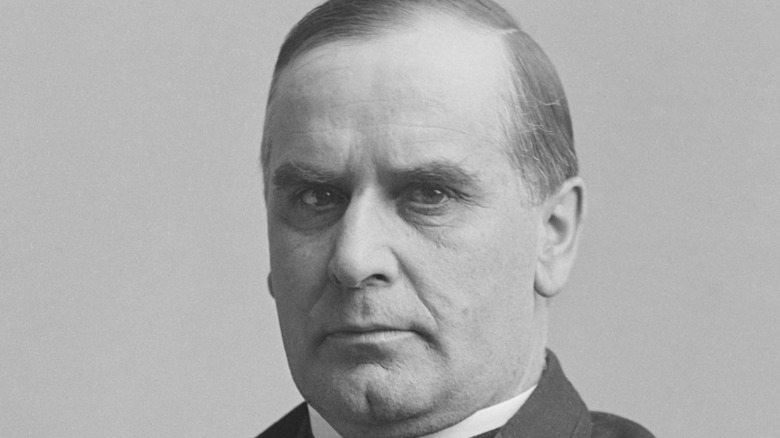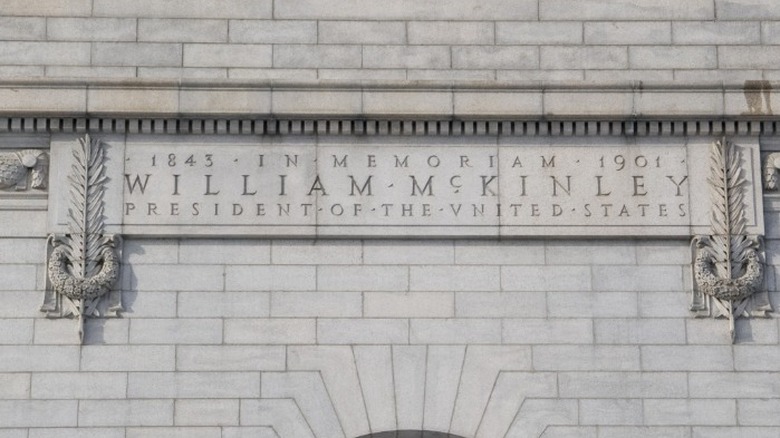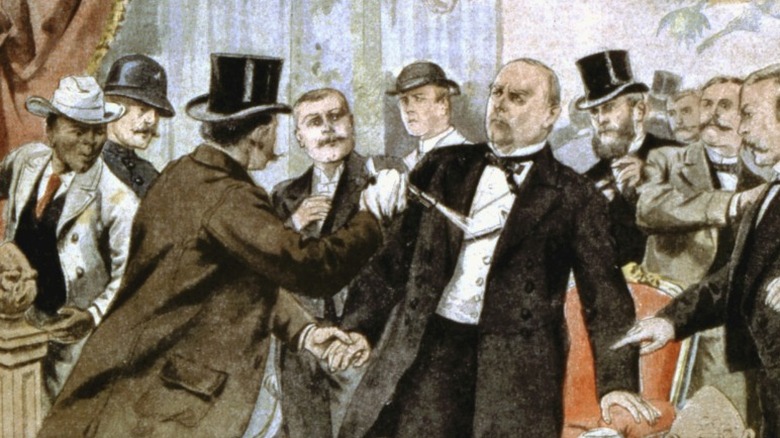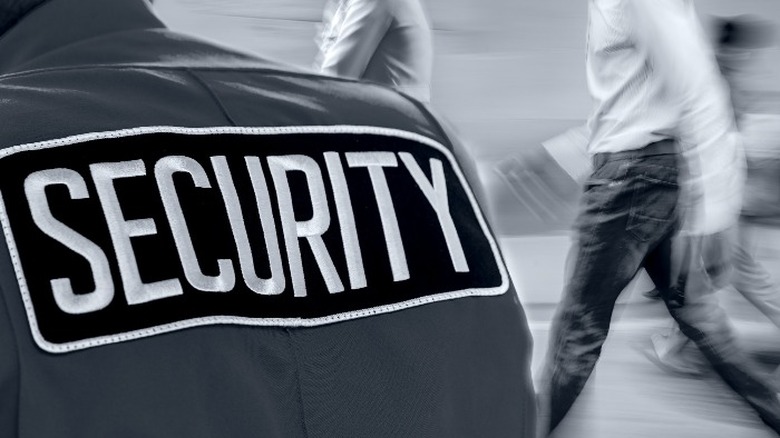What Really Happened After William McKinley Died?
Anyone who recalls their high school U.S. history class could probably tell you about some of the events surrounding the death of William McKinley. While in Buffalo, New York for the Pan-American Expo, McKinley was shot twice by anarchist Leon Czolgosz (via History). He was able to approach McKinley when his turn came to shake the president's hand in a receiving line following a speech.
With his .32 caliber revolver concealed by a handkerchief, Czolgosz fired off two quick and thunderous shots. One bullet was partially deflected by a button on McKinley's shirt, causing minimal damage to his chest. The second shot entered the president's stomach, passing through the organ entirely before lodging somewhere in his back. Before a third shot could be fired, a bystander named James "Big Jim" Parker punched the shooter, who was then almost immediately pinned to the ground by a throng of nearby soldiers and policemen. After being severely beaten for a few moments, Czolgosz was granted mercy from the crowd by McKinley himself. The mortally wounded president ordered the violence against his assassin to cease, to which the crowd respected and responded. Czolgosz was then taken from the scene and interrogated. In the aftermath of the shooting, several things of importance occurred.
A world in mourning
While doctors initially believed that William McKinley might very well survive the assassination attempt, the president passed away eight days after being shot. The bullet that passed through his stomach led to gangrene, which resulted in severe blood poisoning (via History). Thomas Edison himself had offered up an X-ray machine to aid doctors in locating the slug, but they refused, citing McKinley's apparent recovery (via the National Library of Medicine).
Immediately following the news of the death of McKinley, an impressive amount of memorial tributes around the world celebrated the fallen leader. Monarchs across Europe, including British King Edward VII, declared a period of mourning in his honor. Mourners by the thousands viewed McKinley's body as it lay in state in the Capitol rotunda. Soon after, businesses were shuttered, and people gathered in silence as McKinley's funeral train passed through town after town before coming to a rest in his hometown of Canton, Ohio. McKinley was laid to rest in Canton's West Lawn Cemetery on September 19, 1901 (via McKinley Museum).
Swift justice for the assassin
The wheels of justice turned a lot faster in the early 20th century. Leon Czolgosz was placed on trial beginning September 23, 1901, a little more than two weeks after he fired two shots into McKinley (via History). The trial itself was a short-lived affair, as Czolgosz had already confessed his motive to detectives in the aftermath of the shooting, claiming to have assassinated the sitting U.S. president "for the good of the laboring people."
Within three days, Czolgosz was convicted and sentenced to death. According to Britannica, his execution was carried out on October 29, 1901, at Auburn State Prison in New York. He showed no remorse for his devastating actions, even up to the point where he was strapped into the electric chair. The assassin's last words were reported as "I killed the president because he was the enemy of the good people — the working people." With the president dead and buried and his assassin now disposed of, McKinley's successor was now the leader of the free world. Not only that, but the circumstances surrounding three U.S. presidents becoming victims of assassination since 1865 prompted some immediate changes for the incoming commander-in-chief.
Expanding the duties of counterfeit chasers
Upon analyzing the events that led up to McKinley's assassination, it was determined that there was a breakdown in procedure in several ways. For one, a member of the security detail should have been standing on McKinley's left to get a clear view of the right hand of anyone approaching him. Instead, an event coordinator took this position so that he could point out to McKinley noteworthy people who were in line to meet him (via Ohio History Connection). In addition, no one should have had their hand obstructed by any material. Czolgosz was able to conceal his weapon in his handkerchief because it was an unseasonably warm day, and people were using these pieces of cloth to mop their faces. So a disastrous exception was made.
Clearly, some changes needed to be made to the detail that guarded the president, and that's where legislation in D.C. came into play. According to Secret Service, they were commissioned by an act of Congress to expand their role immediately after McKinley's assassination. An official part of the U.S. Treasury Department, the Secret Service was given the responsibility to protect the life of the U.S. president in conjunction with the security detail that was already in place. However, in 1902, the Secret Service was deemed the president's protectors in a full-time capacity. At that time, the detail included two full-time agents.



